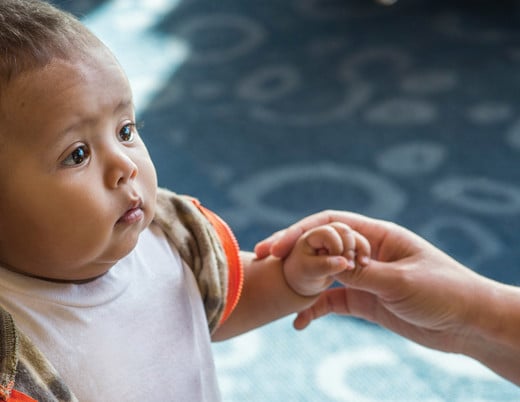Key takeaways
-
Our orthopedic researchers evaluated classification systems for pelvic fractures.
-
A decade of patient records showed that these systems adequately assess pediatric injury severity and help predict management.
-
Air transfers are being used appropriately for more severe injuries.
Background: Pediatric pelvic fractures and injury classification systems
Pelvic fractures are rare in children, but these injuries are associated with significant health issues and even death.
Pediatric pelvic fractures differ from adult pelvic fractures in several ways:
- More force needed to cause fracture due to greater elasticity
- Often result in plastic deformation (bending of the bone in addition to fracture)
- Variety of fracture patterns
There are also challenges with current injury classification systems in pediatrics. The Torode and Zieg pediatric classification broadly groups severe injuries, and adult classifications don’t always accurately describe the injury pattern.
- These factors, and others, often result in pediatric pelvic fracture patients being transferred to a higher level of care with expedited modes of transport.
Methods: 10-year study of pediatric pelvic fractures and injury severity
This 10-year, retrospective study conducted at Children’s Hospital Colorado was led by Julia S. Sanders, MD, director of Pediatric Orthopedic Trauma at the hospital’s Orthopedics Institute.
There were three primary goals of the study:
- Determine if current classification systems for pelvic ring and acetabulum injury correlate with clinical severity in pediatric population
- Assess ability of the classification systems to predict management
- Investigate correlation between transfer patterns and acuity of care
The study took place from January 1, 2010, through December 31, 2020, and the population included 1- to 15-year-olds with presentation of traumatic pelvic ring or acetabular fracture. Pathologic fractures were not included.
Patient care was provided by fellowship-trained orthopedic surgeons in pediatric orthopedics, orthopedic trauma, or musculoskeletal oncology, and all treatment decisions were at the discretion of the orthopedic surgeon in collaboration with other consulting and managing services.
Data collected from electronic medical records included:
- Patient demographics
- Clinical outcomes
- Mechanism of injury
- Date of injury
- Transfer patterns
- Associated injuries
- Injury management
- Complications
- Duration of follow-up
- Follow-up imaging (for time to union)
The severity of injury was determined by:
- Glasgow Coma Scale (GCS)
- Injury Severity Score (ISS)
- Hemodynamic status
- Blood products use
- Need for interventional radiology
- Weight-bearing status
- Need for critical care
The injury pattern classification systems used included Judet-Letournel and modified Bucholz for acetabular/triradiate injuries, and Young and Burgess, Torode/Zieg and Arbeitsgemeinschaft für Osteosynthesefragen/Orthopaedic Trauma Association (AO/OTA) for pelvic ring injuries.
Results: classification of pelvic injury, severity, transfer and management
Patient and injury characteristics



Most injuries were sustained as polytraumas, with 70.1% having additional injuries.
- Classification of fractures based on available imaging
- 65.5% AO/OTA 61B
- 62.7% Young and Burgess LCI
- 65.5% Torode/Zieg Type III
- Imaging
- 90.4% had both plain radiographs and computed tomography (CT) scans
- 2.7% had only plain radiographs or only CT scans
Median length of stay by acuity of care
- 4 days: all patient average
- 3 days: pediatric intensive care unit (PICU) patients
- 7 days: surgically treated patients
Follow-up for patients who could be tracked
- 0 to 62 months clinical
- 1 to 52 months radiographic
Injury classification, severity, and management

The study authors tested the association between injury acuity and injury characteristics, defining severity by need for surgery or pediatric intensive care unit (PICU) admission.
They found that 27.1% of patients needed operative treatment, which was significantly associated with:
- Increasing fracture severity
- AO/OTA
- OR: 21.45
- P-value<0.001
- Young and Burgess
- OR: 28.33
- P-value<0.00
- AO/OTA
- Increasing Injury Severity Score (ISS)
- OR: 1.04
- P-value=0.0017
- Decreasing hemoglobin levels
- OR: 0.76
- P-value=0.0144
- Age
- OR: 1.11 per 1-year increase
Surgical procedures included:
- 73% percutaneous fixation of the posterior ring
- 33% anterior fixation
- 29% external fixation
They found that 41% of patients needed PICU admission, which was significantly associated with:
- Lower Glasgow Coma Scale (GCS)
- OR: 0.13
- P-value=0.003
- Lower hemoglobin
- OR: 0.83
- P-value=0.0462
- Increasing Injury Severity Score (ISS)
- OR: 1.21
- P-value<0.001
Blood products used
Overall, 17.6% of patients received a blood transfusion during trauma management. Of those patients, 45.5% were operative cases and 23.2% were nonoperative cases.
The need for a blood transfusion was significantly associated with:
- Decreasing hemoglobin level
- P-value=0.000
- Increasing severity of injury
- Injury Severity Score (ISS)
- OR: 1.13
- P-value<0.001
- AO/OTA classification severity
- OR: 1.11
- P-value=0.0138
- Torode/Zieg classification severity
- OR: 3.74, P-value=0.0015
- Injury Severity Score (ISS)
Injury characteristics and transfer patterns
Injury characteristics and/or injury acuity did not differ between patients who were transferred before definitive care versus patients who were brought in directly from the field. Of the 79.1% of patients transferred one or more times to a higher level of care, treatment acuity and/or injury severity was not significantly different among in-state and out-out-of-state transfers.
Air transfer was significantly associated with:
- Surgical treatment
- OR: 2.37
- P-value=0.036
- PICU stay
- OR: 6.14
- P-value<0.0001
- Additional injuries
- OR: 2.4
- P-value=0.0297
- Higher injury severity (Torode/Zieg)
- OR: 1.08
- P-value=0.003
Discussion and conclusion: Existing pelvic injury classification systems have value in pediatrics
Study authors noted that while available classifications systems may not be perfect for the assessment of these types of pediatric injuries, they are valuable for assessing overall injury severity and the need for a higher level of care.
Findings from this study suggest that:
- Most pediatric pelvic ring and acetabular injuries do not require surgery, which corroborates smaller, previously published studies.
- Air transfer, although costly, is warranted and is being appropriately utilized to accelerate an advanced level of care for this patient population. The fact that Children’s Colorado is the only level 1 trauma center for six states may influence this finding.
The study authors concluded that operative management of pelvic ring and acetabular injuries still has a role in managing these injuries, but that most of the injury patterns can be managed nonoperatively. More studies with long-term follow-up will help further guide decisions for triage and treatment for these rare, severe injuries.





 720-777-0123
720-777-0123










